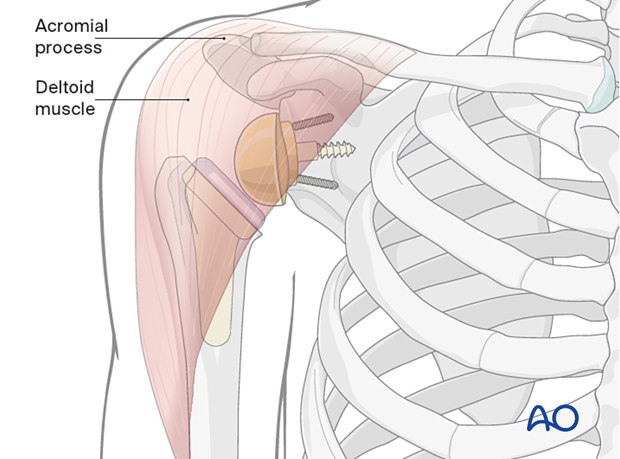Avulsion of the acromion
General considerations
Fractures of the acromial process are classified by UCPF as I.14-A2.

Fractures of the acromial process are common.
The acromial process is the bony origin of the middle, and part of the anterior third, of the deltoid muscle. The stability and anatomical position of the acromial process is therefore of utmost importance in shoulder function.

This importance is even more significant in reversed shoulder arthroplasty due to the role of the deltoid muscle.

Etiology
Avulsion of the rim of the acromion can be caused by:
- Direct trauma on the lateral aspect of the shoulder
- Weakening due to previous surgery
- Deltoid tension in reverse total shoulder replacement
Fractures through the body of the acromion can be caused by:
- Direct trauma on the posterolateral aspect of the shoulder
- Deltoid tension in reverse total shoulder replacement
Pitfall: It is important to distinguish traumatic fractures of the body of the acromion from os acromiale. Os acromiale is a common finding in rotator cuff care arthropathy for which reverse total shoulder replacement is often performed. Os acromiale is frequently asymptomatic and may not have a functional significance. A fracture of the acromion is always symptomatic and nearly always has a functional consequence.
The risk of acromial fractures (both traumatic and fatigue) increases in reverse total shoulder replacement due to increased deltoid muscle tension.
Clinical signs
- Pain over the superior lateral aspect of the shoulder
- Weakness mainly in abduction but also in forward flexion
- There may be a palpable gap in the acromion process
- Visible deformity if displaced
- In the case of os acromiale, patients may have a history of previous shoulder pain
Imaging
- Lateral and scapular Y x-rays may show the fracture
- CT scan is the definitive imaging
Pearl: The preoperative x-rays and CT scans will show an os acromiale if present and help to distinguish this from an intraoperative or postoperative acromial fracture.













